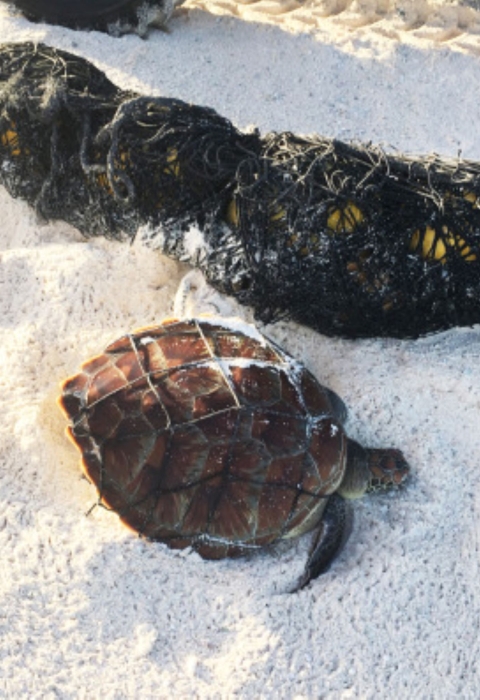This year is the 50th anniversary of the Endangered Species Act, a law that has been a powerful catalyst for conservation of America’s most treasured fish, wildlife, plants and their habitats. In the Pacific Region, our Tribes, state and federal agencies, and partners have joined with our dedicated staff to be the driving force behind the successes we share and the strength ensuring we can address the challenges ahead. Celebrate this milestone with us in this collection of stories as we reflect on past successes, assess current challenges, and envision an equally bright future for the next 50 years and beyond.
What started as a regular morning on a routine beach inspection at the Guam National Wildlife Refuge turned into a heroic rescue of an endangered green sea turtle – also called a haggan betde in the native CHamoru language.
Refuge maintenance supervisor Brian Leon Guerrero, and acting Refuge manager John Blitch, were completing a routine morning beach patrol which includes: looking for fresh sea turtle tracks that may indicate recent nesting activity, picking up marine debris washed up on the shore of the Refuge, and counting and identifying birds.
Their patrol turned out to be anything but routine when they spotted a large fishing net that wash up on the beach. Upon closer inspection they discovered a sea turtle trapped in the net. These types of lost or abandoned fishing lines, nets, and traps that drift in the water trapping and killing marine life are a specific kind of marine debris known as ghost nets.
At first they thought the turtle had already become another casualty of a ghost net, but then they saw that it was still alive and sprang into action to save the entangled turtle. The pair was able to cut the netting to free the turtle which quickly made its way back to the ocean and swam away. Thanks to the heroic efforts of Brian and John the turtle lived to swim another day!
Marine debris including ghost nets, can entangle and harm all types of marine animals. For air-breathing animals like the endangered green sea turtle, entanglement in debris can prevent them from being able to swim to the surface to breathe, causing them to drown.
While Brian and John were able to save this sea turtle, countless others are not as lucky. Ghost nets can float around the ocean passively continuing to fish and trap other wildlife potentially for many years or even decades. Each year over 1 million marine animals (including mammals, fish, sharks, turtles, and birds) die due to marine debris, according to the Sea Turtle Conservancy. A University of Queensland study found that more than half of the world’s sea turtles have ingested some plastic or human garbage.
Marine debris is a globally pervasive issue that poses a significant threat to the marine environment. To learn more about marine debris, what is being done to address it, and how you can help, please visit the National Oceanic and Atmospheric Administration’s Marine Debris Program website.
Visit Guam National Wildlife Refuge
Guam National Wildlife Refuge is located on the island of Guam, an unincorporated U.S. Territory. Guam is the largest and southernmost island in the Mariana Archipelago, situated in the western Pacific Ocean. The Refuge is open daily from 7:30 am to 4:00 pm, with closures on all major federal holidays. For more information please visit the Refuge website: www.fws.gov/refuge/guam
###
The U.S. Fish and Wildlife Service works with others to conserve, protect, and enhance fish, wildlife, plants, and their habitats for the continuing benefit of the American people. For more information, visit www.fws.gov/pacificislands, or connect with us through any of these social media channels at https://www.facebook.com/PacificIslandsFWS, www.flickr.com/photos/usfwspacific/, https://medium.com/usfwspacificislands or www.twitter.com/USFWSPacific.




